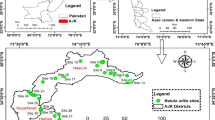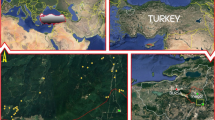Abstract
Wildfires in recent years have resulted in degradation and damage to the Hyrcanian forest ecosystems in Northern Iran. This study was carried out to investigate fire damage to trees and changes in regeneration in early-season growth after wildfires in the Golestan Province. For this purpose, a random sampling plan was used, with 60 circular plots (each plot is 1000 m2) for each stand and 240 circular (25 m2) plots for regeneration within the burned and unburned areas, respectively. In each plot, habitat factors were recorded, including crown canopy percentage, forest stratum, herb-layer cover percentage, species, diameter at breast height, tree and regeneration quality, and quantity of seedlings and saplings. Our results showed that bark is an important factor for fire resistance in Hyrcanian forests. The Persian ironwood and European yew has the highest and lowest fire resistance; as broad leave species are more resistant than needle leaf species. Density of regeneration in unburned area was higher than burned area, and statistical analysis showed significant differences for all species between two areas. Fire effects on sapling were different among species which indicates sapling has different resistance to fire. Forest floor fuel, season, stand composition and microclimate have more effects on fire severity while environmental factors, regeneration and management practices shaping future composition stands.






Similar content being viewed by others
References
Agee JK (1993) Fire ecology of Pacific Northwest forests. Island Press, Washington DC, p 493
Agee JK, Skinner CN (2005) Basic principles of forest fuel reduction treatments. For Ecol Manag 211:83–96
Amman GD, Ryan KC (1991) Insect infestation of fire-injured trees in the Greater Yellowstone Area. Research Note INT-398, USDA Forest Service, Intermountain Forest and Range Experiment Station, Ogden, UT
Banj Shafiei A, Akbarinia M, Jalali G, Hosseini H (2010) Forest fire effects in beech dominated mountain forest of Iran. For Ecol Manag 259:2191–2196
Brown JK, Smith JK (eds) (2000) Wild land fire in ecosystems: effects of fire on flora. General Technical Report RMRS-GTR-42-Vol 2. U. S. Department of Agriculture, Forest Service, Rocky Mountain Research Station, Ogden, UT
Butler BW, Dickinson MB (2010) Tree injury and mortality in fires: developing process-based models. Fire Ecol 6(1):55–79
Calvo L, Santalla S, Marcos E, Valbuena L, Tarrega R, Luis-Calabuig E (2003) Regeneration after wildfire in communities dominated by Pinus pinaster, an obligate seeder, and in others dominated by Quercus pyrenaica, a typical resprouter. For Ecol Manag 184:209–223
Catry F, Rego F, Moreira F, Fernandes P, Pausas J (2010) Post fire tree mortality in mixed forests of central Portugal. For Ecol Manag 260:1184–1192
Crotteau JS, Varner JM, Ritchie MW (2013) Post-fire regeneration across a fire severity gradient in the southern Cascades. For Ecol Manag 287:103–112
Diaz-Delgado R, Lloret F, Pons X (2004) Spatial patterns of fire occurrence in Catalonia, NE, Spain. Landsc Ecol 19:731–745
Dominguez L, Calvo L, Luis E (2002) Impact of wildfire season on regeneration of Quercus pyrenaica forest and Pinus sp. stands. J Mediter Ecol 3:47–54
Ellis LM (2000) Short-term response of woody plants to fire in a Rio Grande riparian forest, Central New Mexico, USA. Biol Conserv 97:159–170
FAO (2005) Global forest resources assessment, progress towards sustainable forest management. FAO, Rome
FAO—Food and Agriculture Organization of the United Nations (2001) Global Forest Fire Assessment 1990–2000, UN
Fernandes PM (2010) Creating fire-smart forests and landscape. Mediterranean forest week of Antalya, Antalya, pp 417–722
Fettig CJ, McKelvey SR, Cluck DR, Smith SL, Otrosina WJ (2010) Effects of prescribed fire and season of burn on direct and indirect levels of tree mortality in Ponderosa and Jeffrey pine forests in California, USA. For Ecol Manag 260:207–218
Fowler JF, Sieg CH (2004) Post fire mortality of ponderosa pine and Douglas-fir: a re-view of methods to predict tree death. USDA Forest Service General technical report RMRS-GTR-132. Rocky Mountain Research Station, Fort Collins, Colorado, USA
Goldhammer JG (1999) Forests on fire. Science 284:1782–1783
Gonzalez JR, Palah M, Trasobares A, Pukkala T (2006) A fire probability model for forest stands in Catalonia (north-east Spain). Ann For Sci 63:169–176
Haugaasen T, Barlow J, Peres CA (2003) Surface wildfires in central Amazonia: short-term impact on forest structure and carbon loss. For Ecol Manag 179:321–331
Hermann R, Lavender, D (1990) Pseudotsuga menziesii (Mirb.) Franco. In: Burns RM, Honkala BH, (eds) Silvics of North America. US Department of Agriculture Forest Service, Washington, DC, pp 522–540
Hood SM, McHugh CW, Ryan KC, Reinhardt E, Smith SL (2007) Evaluation of a post-fire tree mortality model for western USA conifers. Int J Wild land Fire 16:679–689
Hood SM, Cluck DR, Smith SL, Ryan KC (2008) Using bark char codes to predict post-fire cambium mortality. Fire Ecol 4:57–73
Lotfi A (1999) Effect of fire in Khiroudkenar Forest. M.Sc. Seminar. Tehran University, p 44
Mantgem PJ, Schwartz M (2004) An experimental demonstration of stem damage as a predictor of fire-caused mortality for ponderosa pine. Can J For Res 34:1343–1347
Mantgem PJ, Stephenson NL, Mutch LS, Johnson VG, Esperanza AE, Parsons DJ (2003) Growth rate predicts mortality of Abies concolor in both burned and unburned stands. Can J For Res 33:1029–1038
Marvie Mohajer MR (2006) Silviculture. Tehran University Press, Tehran In Persian
Marzano R, Lingua E, Garbarino M (2012) Post-fire effects and short-term regeneration dynamics following high severity crown fires in a Mediterranean forest. iForest 5:93–100
Moreira F, Duarte I, Catry F, Acacio V (2007) Factors affecting post-fire cork oak survival in southern Portugal. For Ecol Manag 253:30–37
Oliveira S, Fernandes PA (2009) Regeneration of Pinus and Quercus after fire in Mediterranean-type ecosystems: natural mechanisms and management practices. Silva Lusit 17(2):181–192
Phillips RJ, Waldrop TA (2008) Change in vegetation structure and composition in response to fuel reduction and composition in response to fuel reduction treatments in the South Carolina Piedmont. For Ecol Manag 225:3107–3116
Proença V, Pereira HM, Vicente L (2010) Resistance to wildfire and early regeneration in natural broadleaved forest and pine plantation. Acta Oecol 36:626–633
Sagheb-Talebi K, Sajedi T, Yazdian F (2004) Forests of Iran. Research Institute of Forests and Rangelands, Tehran
Shatford JPA, Hibbs DE, Puettmann KJ (2007) Conifer regeneration after forest fire in the Klamath-Siskiyous: how much, how soon? J For 105:139–146
Sieg CH, McMillin JD, Fowler JF, Allen KK, Negrfn JF, Wadleigh LL, Anhold JA, Gibson KE (2006) Best predictors for postfire mortality of ponderosa pine trees in the Intermountain West. For Sci 52:718–728
Spanos IA, Daskalakou EN, Thanos CA (2000) Postfire, natural regeneration of Pinus brutia forests in Thasos island, Greece. Acta Oecol 21(1):13–20
Thanos CA, Daskakakou EN, Nikolaidou S (1996) Early postfire regeneration of a Pinus halepensis forest on Mount PaÂrnis, Greece. J Veg Sci 7:273–280
Thies WG, Westlind DJ, Loewen M (2005) Season of prescribed burn in ponderosa pine forests in eastern Oregon: impact on pine mortality. Int J Wildland Fire 14:223–231
Trabaud L (1988) Survie de Jeunes plantules de pin d’Alep apparues apreÁs incendie. Stud Oecol 5:161–170
Van Wagner CE (1978) Age-class distribution and the forest fire cycle. Can J For Res 8:220–227
Whelan RJ (1995) The ecology of fire. Cambridge University Press, Cambridge
Zald HSJ, Gray AN, North N, Kern RA (2008) Initial tree regeneration responses to fire and thinning treatments in a Sierra Nevada mixed-conifer forest, USA. For Ecol Manag 256:168–179
Acknowledgments
The authors are grateful to Nemat Dylam, Alireza Tanburani, Saeed Dylami, and Mostafa Amirnia for their valuable contributions to fieldwork and data preparation.
Author information
Authors and Affiliations
Corresponding author
Additional information
The online version is available at http://www.springerlink.com
Corresponding editor: Hu Yanbo.
Rights and permissions
About this article
Cite this article
Yadegarnejad, S.A., Jafarabad, M.D. & Savadkoohi, N.M. Surface wildfire in conifer broad-leaved forests of the Hyrcanian region of Iran: short-term effect on regeneration and damage to trees. J. For. Res. 26, 425–434 (2015). https://doi.org/10.1007/s11676-015-0046-8
Received:
Accepted:
Published:
Issue Date:
DOI: https://doi.org/10.1007/s11676-015-0046-8




